How to Feed the Baby Real Food on Live
When to Start
Every baby is unique, and babies will be prepare for solid food at different times. Breastmilk is the main source of nutrition for the beginning yr of life and it is recommended that you exclusively breastfeed your baby for the first half dozen months of life and proceed to breastfeed after the introduction of solids until the age of effectually 2 years.
Babies are frequently set for solids around half dozen months of age, but not before iv months. At the historic period of around 6 months, your babe is not receiving enough iron from breastmilk or formula to meet their requirements and therefore atomic number 26-containing foods and other solid foods should be introduced. First your babe on solids when they are showing these signs of readiness:
- Your baby can hold their head upwards
- Your baby can sit with less help
- Your baby is interested in food and may attain for your food
- Your baby opens their rima oris when food approaches
- Your baby tin keep food in their mouth without pushing information technology out
- Your infant is showing signs of biting and chewing
A lot of parents start their baby on solids in the hope that they may sleep through the nighttime. For a small number of parents this works (and these are the ones that are boasting most information technology), but for the majority of babies, starting solids will non change their night waking. It is important to remember that babies wake in the night because they desire comfort, they desire the warmth and nourishment of a breastfed, they are likewise hot/cold, they are stuck in a position they cannot get out of, and a number of other reasons why they demand mum or dad.
Puree or Infant-Led approach?
There are commonly two approaches to starting solids which are offer puree foods on a spoon, which is traditionally called 'spoon feeding', and the babe-led approach which is offering whole soft foods for your child to self-feed.
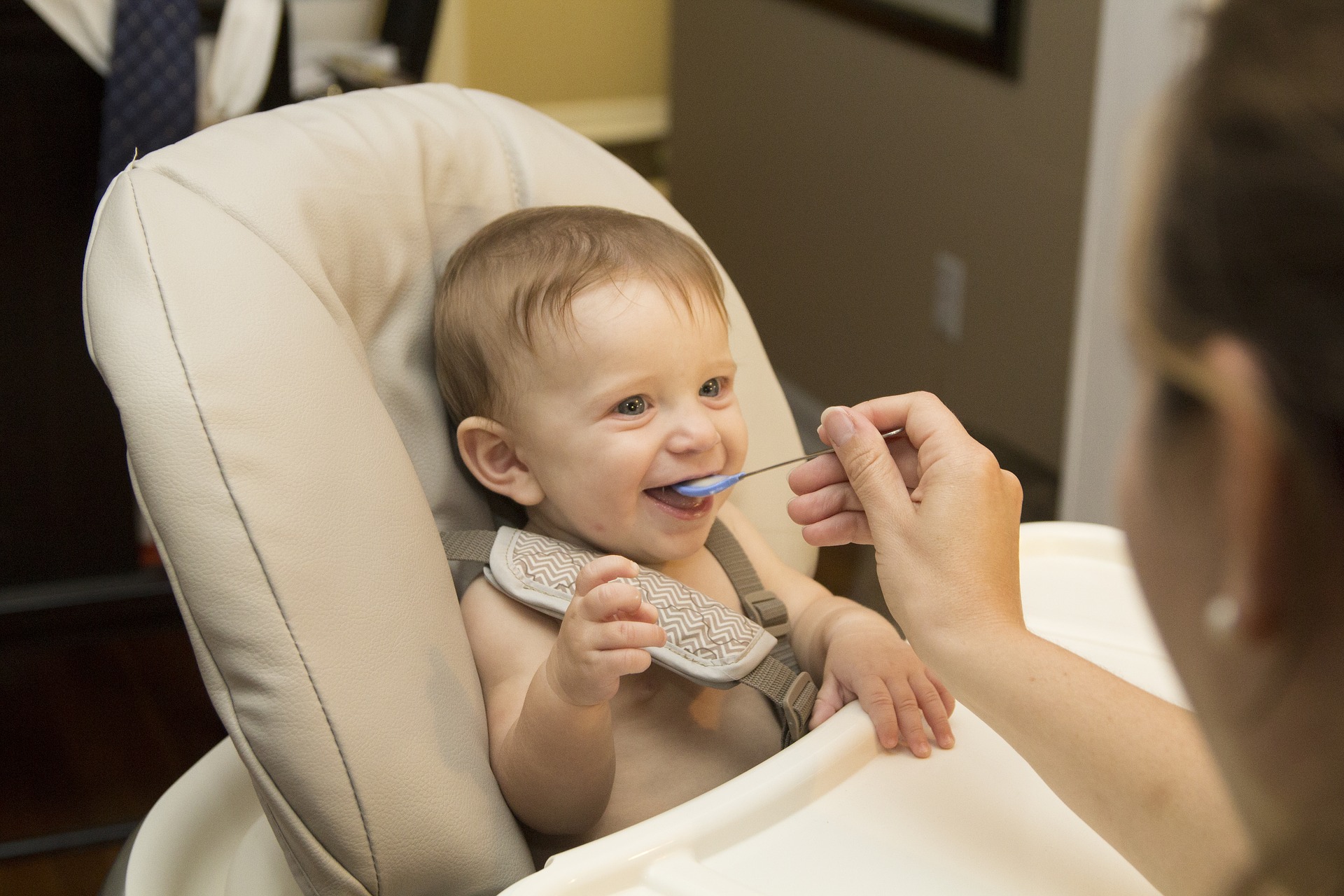 Spoon feeding can start from four-vi months of age and involves offering very smooth puree to your baby on a spoon. Over the first yr of life the texture of the food becomes more lumpy or harder to chew, until at 12months of age when most nutrient textures are tolerated. Showtime foods might be puree vegetables, puree fruit, puree meats/other proteins and iron-fortified cereals.
Spoon feeding can start from four-vi months of age and involves offering very smooth puree to your baby on a spoon. Over the first yr of life the texture of the food becomes more lumpy or harder to chew, until at 12months of age when most nutrient textures are tolerated. Showtime foods might be puree vegetables, puree fruit, puree meats/other proteins and iron-fortified cereals.
Choose foods that are important to your family and alloy family meals when suitable. When feeding your baby it is important to listen to their cues on when they are ready to stop eating. When pureeing the babies food information technology is a skillful thought to puree foods separately rather than all together.
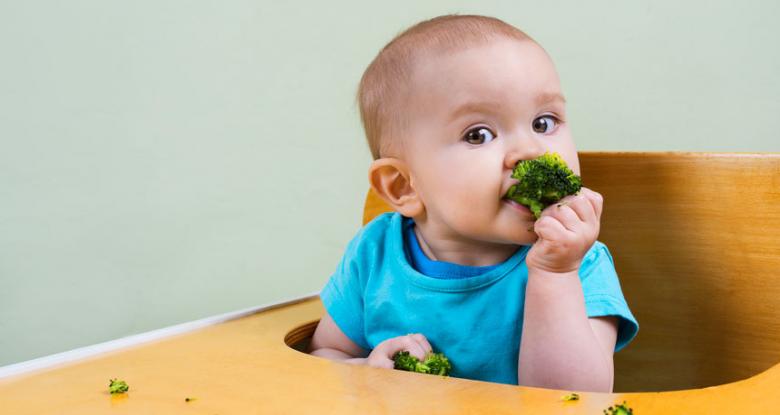
Baby-led weaning can kickoff from six months, merely non before this historic period every bit they are not developmentally ready. This approach involves giving your child soft cooked sticks of vegetables, fruit, meat/fish or other whole foods given on their loftier chair tray and they are encouraged to feed themselves. At that place is a trend to offer fruits and vegetables only with this approach, and then it is of import that soft protein foods such as meat, fish, lentil patties, beans are offered to meet atomic number 26 needs. Iron-fortified baby rice or baby cereals tin can be given on top of vegetables or bread slices.
Research comparing the 2 approaches is express. The baby-led approach may not requite acceptable atomic number 26 and zinc, so iron-fortified baby cereals given as a dip or spread on toast, and meat/fish/craven in the nutrition is important. The baby-led weaning approach can lead to lower intake of vitamin B12, vitamin C and calcium compared to children offered puree food. Many parents worry about the chance of choking with the infant-led approach simply a babe tin choke of any texture of nutrient and when feeding your kid you should be with them in instance choking occurs. The baby-led arroyo should but be introduced from half dozen months, and then if you want to start before then puree foods should be offered. At that place is some enquiry to propose that the baby-led arroyo leads to less food fussiness, quicker paw-eye co-ordination and reduction in gag reflex than those on puree nutrition. No approach is necessarily ameliorate than the other and ofttimes a combination of puree and finger foods works well. In that location are times when babies are tired and need help to feed, and other times they want to be contained and feed themselves, and then being flexible to offer both options is ideal. It is important to listen to your babies cues and find out which approach suits them best.
Amounts to Offer
Babies receive the bulk of their nutrition from breastmilk or formula during the kickoff year of life. Breastmilk should be offered before solid foods for the first few months of solids introduction. When you first introduce solids offset with 1-two teaspoons puree or a very minor amount of soft finger foods if using baby-led approach. For the first few weeks offering one meal per day will be acceptable for baby and they will take varying amounts from ½ teaspoon to ½ cup depending on the baby. After 1-ii weeks on one meal per day they can increase to 2 meals and finally to three meals when they are ready. In that location is no need to rush this and let your child guide yous on when they are gear up for other meals during the mean solar day. The most important office of the repast is that the baby is enjoying the experience and they are allowed to look, aroma, gustatory modality, and touch the food they are eating. Heed to your babies cues on when they are finished with the meal, for instance they may plough their head away, shut rima oris, spit out food, push food away, or go upset.
When feeding your baby it is good to recall well-nigh your role as the parent and your child'southward part in feeding. Babies accept an amazing ability to command the amount of food and milk they need to ensure they are growing at their own rate.
Parents office:
- What (your kid is eating, east.g. cereal, vegetables)
- When (your child is eating, e.grand. morning tea, dejeuner)
- Where (your child is eating, e.g. highchair, tabular array)
Childs role:
- How much (they are willing to eat, e.g. 1 teaspoon or two bowls)
- Whether (they are going to eat it)
If you are worried that your child is unhappy to accept solid foods and/or is not progressing with nutrient intake, then contact your GP, plunket nurse and/or a Dietitian.
Embrace the Mess
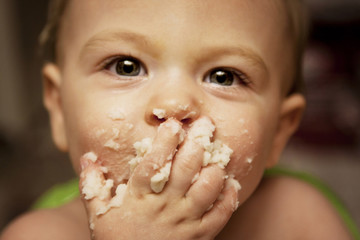
Learning to eat solid foods is messy and this is all part of the feel of eating for a baby. Let your child to touch the food, move food with their fingers, or spread nutrient around their face as this is also office of the eating experience. Avoid cleaning up your child until after they accept finished eating. Messy play outside of mealtimes, such as playdough, sand etc are as well important for development of feeding skills and exploration of textures to help with acceptance of new foods.
When to Introduce Certain Solids
Starting babies on solids is an important fourth dimension to offering iron-containing foods, such as fortified baby cereals/rice, or puree/soft meat/fish/chicken/lentils. Past 6 months of age your babies iron stores laid down from pregnancy accept decreased and breastmilk does not comprise adequate amounts of iron to see requirements. Forth with iron-containing foods your baby tin can likewise be offered a variety of vegetables, fruit, breads, cereals, milk products, cooked eggs and nut butters.
There is a lot of defoliation around when to start sure foods and many parents feel confused about the deviation in opinion. However, if y'all follow the Ministry of Health, World Health Arrangement and Australian Club of Immunology and Allergy (ASCIA) the recommendations are age-appropriate foods existence introduced from around 6 months but not before 4 months of historic period. When we look at risk for food allergy the consensus is to introduce food allergens (eastward.g. milk, egg, nut, soy, wheat, fish) from effectually 6 months and past 12 months of age. Early introduction from effectually vi months and before 12 months of both egg and nuts has a reduced risk of allergy.
Nigh foods tin can be introduced from around 6 months with some exceptions, such as grapes due to choking risk, beloved due to the risk of the botulism bacteria, salt, sugar, and whole nuts due to choking risk. See below for more information almost reducing choking risk.
| From 4-6 months | Vegetables, fruit, cooked egg, peanut or other nut butters, cooked meat/fish/seafood/chicken/lentils/beans, fe-fortified baby cereals, oats, depression fibre wheat bread, dairy products, soy. |
| From seven-viii months | Introduce finger foods and lumpy textures if following traditional spoon feeding. Higher fibre foods tin can be gradually introduced. |
| From 12 months | Beloved, Moo-cow's milk as a chief potable, fermented foods, foods that contain table salt and carbohydrate. |
| From v years | Whole nuts |
Vegetables and Fruit
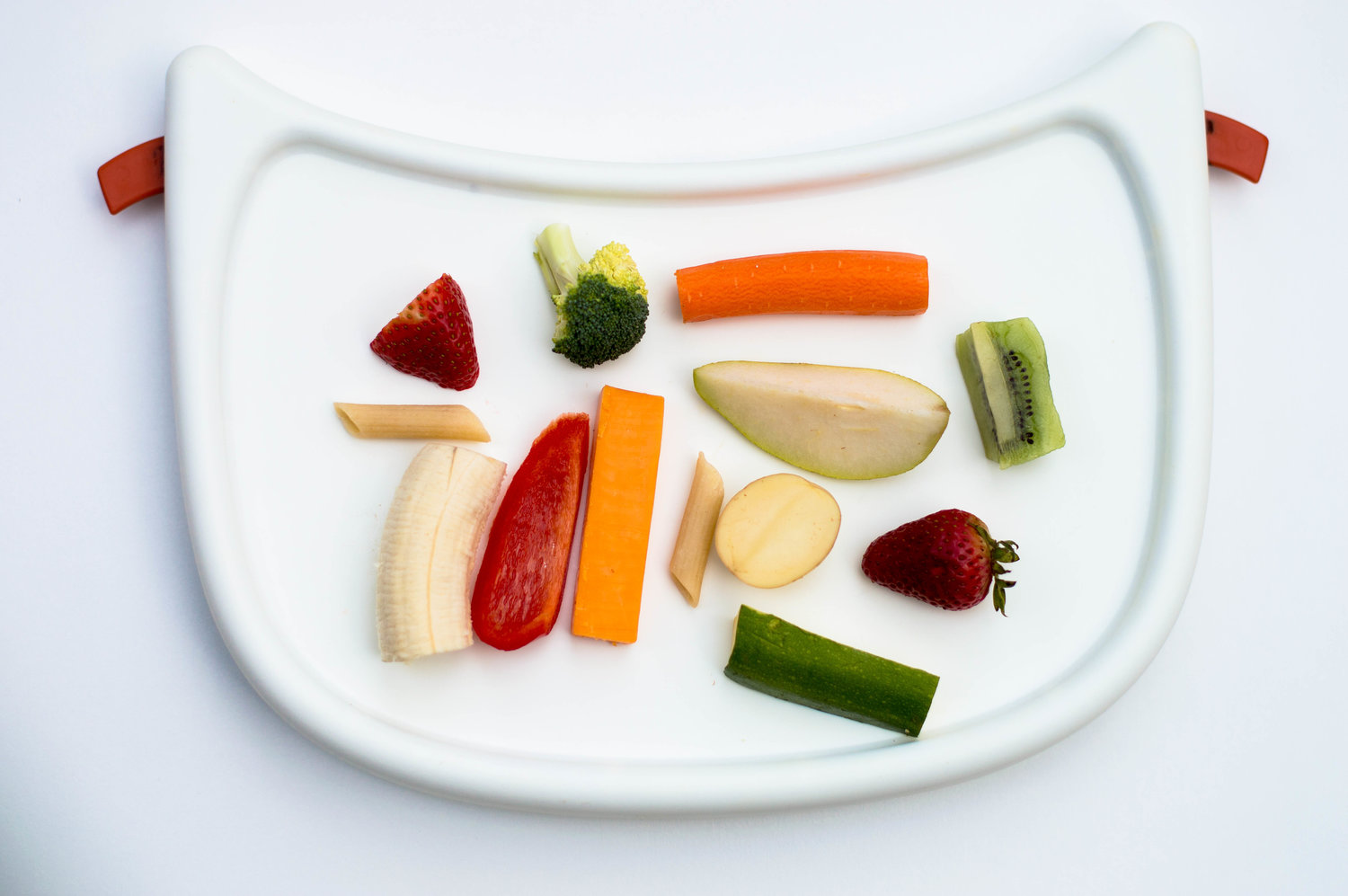
Vegetables and fruit are groovy first weaning foods. Information technology is important to offer vegetables on their own at times, rather than always mixed with fruit to get infant used to more than savoury vegetable flavours. Ofttimes the starchy vegetables such as kumara, carrot, potato and pumpkin are easy to blend to a polish texture and can be combined with proteins, such as cooked lentils/fish/meat/craven. When giving vegetables and fruit to your babe, you tin puree with breastmilk or formula to feed off a spoon, or cut into strips which are around 6-10cm long and 1-2cm thick. Information technology is nice to blend similar colours together to keep the meal visually appealing for your baby, for instance blend carrot with pumpkin, and broccoli with spinach. Aim to offering homemade fruit and vegetables as much as possible. Canned, jarred or squeezie tube purees are useful when you are out and about, but should not be given every mean solar day. Squeezie tube purees can be high in sugar and oftentimes exercise not allow the baby to run into the nutrient, smell the food and they can go a shock when they clasp the tube too tightly and the nutrient shoots to the dorsum of their mouth. If using squeezie tubes, then try to squeeze puree into a bowl and permit the kid to feel all of the food rather than only the flavor.
Protein foods
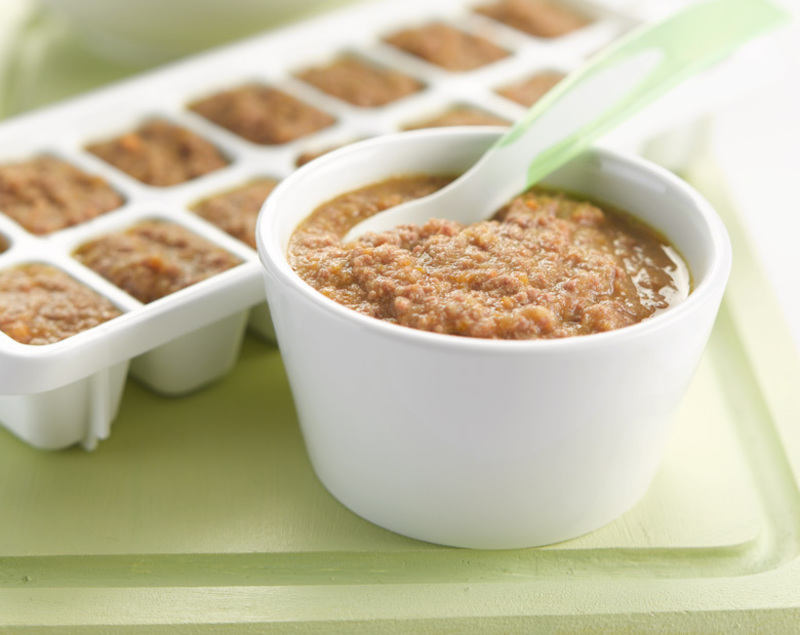
Protein is important for growth and should be offered at least twice over the day. Poly peptide comes from meats, such as lamb or beef, craven, eggs, lentils, beans and fish. Poly peptide foods contain fe and this needs introduction from vi months of age. Meats tin be composite to make a polish puree and you can use breastmilk or formula to become the texture smoothen. You tin offer puree meat on a spoon or spread on bread/vegetable sticks for your babe to suck off if using the baby-led arroyo. Whole strips of meat can be offered to babies from 6 months but ensure they are effectually 6-10cm long and 1-2 cm thick and cooked so that the baby can nonetheless suck plenty of the meat juices out. Yous can place the meat into a mesh pocketbook if you are worried about choking.
Fats
Fatty is essential for babies to see their requirements for fat-soluble vitamins but also to give acceptable calories for growth. Healthy fats from avocado, fatty fish, basics, seeds and extra virgin olive oil should exist a regular role of their diet.
Grains
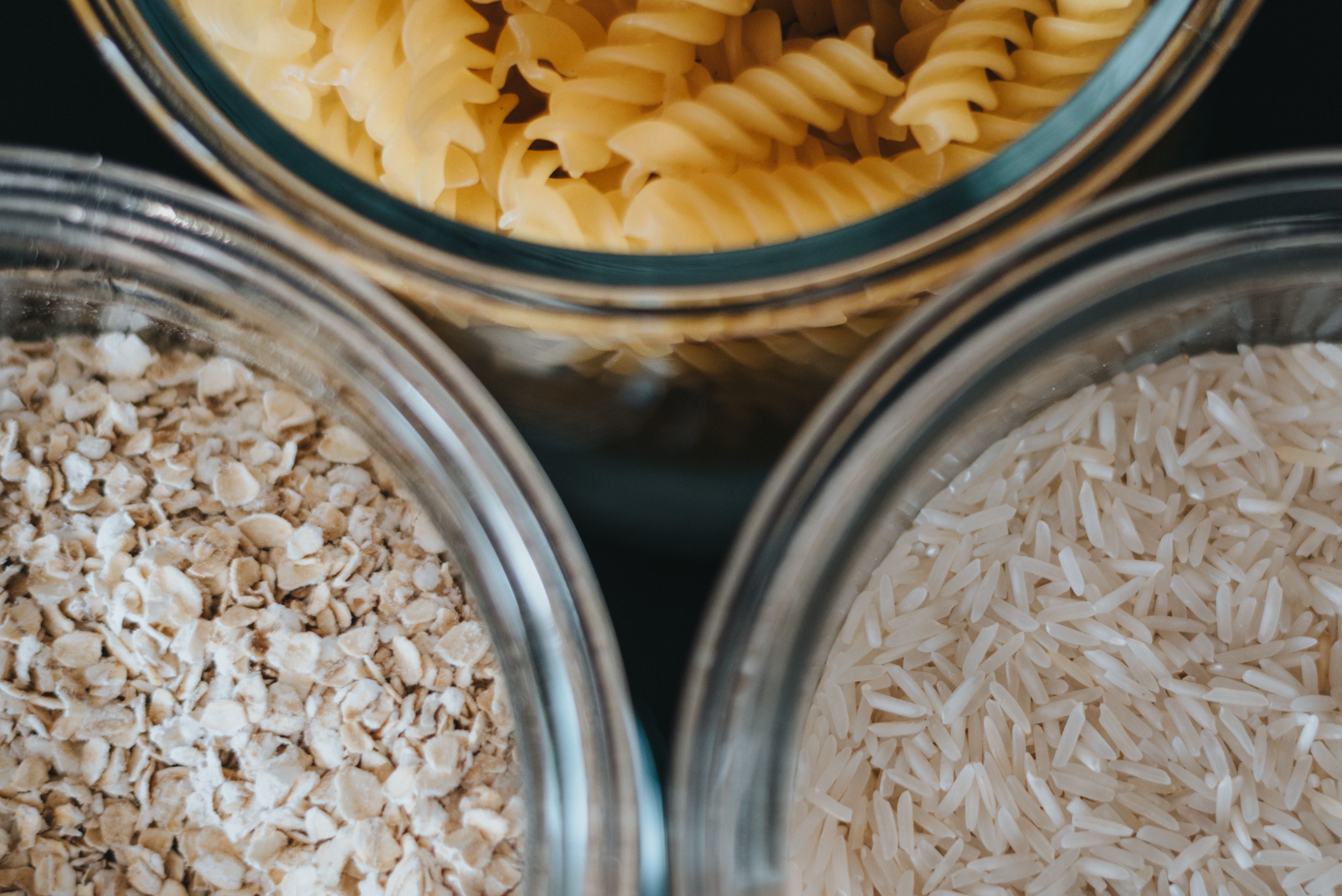
Grains can be introduced slowly into your babies' diet from around 6 months with ho-hum introduction to permit your infant to adapt to changes in fibre. Iron-fortified cereals or baby rice can be mixed with breastmilk or formula. Some babies tin become slightly constipated with some babe cereals, so ensure they are offered vegetables and fruit alongside this and plenty of breastmilk. Oats tin can be finely footing and mixed with formula or baby rice and given as a blazon of porridge. Pasta and rice can exist pureed and/or given as whole foods after 6 months. Bread can be introduced from 6 months and start with white bread with ho-hum introduction of higher fibre or grainy breads as they become older and their gut adapts to increased fibre.
Just I heard babies couldn't digest grains?
Over the internet there take been circulating concerns around introducing grains and starch in the first year of life due to depression levels of amylase in babies. Notwithstanding, there is no conclusive evidence to propose this is necessary and avoidance of grains may increase the hazard of allergy and type Two diabetes. Introduction of grains in the kickoff year of life does not increment risk of coeliac disease.
Starch, which is contained in grains and starchy foods such as potato and kumara, are start digested in the oral fissure with salivary amylase and then further digested by digestive amylase in the modest intestine. Digestive amylase is low in infants, merely it starts to increment around 4 months of age and reach adult levels past 1-2 years of age. Babies produce quite high levels of saliva and the salivary amylase may help their digestion of starches to combat the lower levels of digestive amylase. Breastmilk has high levels of amylase so breastfeeding your babe earlier giving them solids volition aid them break down starch. At that place is also higher levels of an enzyme called glucoamylase in the small-scale intestine of a baby, which is likely to help pause down starch.
Salt
In the offset twelvemonth of life table salt should not be added to foods as the kidneys are all the same developing. Salt does non demand to exist added to foods for babies as they have fantastic gustatory modality buds and foods that may announced banal to an adult are likely to be enjoyable for a baby. Foods containing high salt (sodium), such every bit canned or packaged goods should be used in small-scale amounts in babies. Aim for lower common salt foods by looking for foods containing <300mg sodium per 100g.
Carbohydrate
Children should not have additional table sugar added to foods. Foods that take natural sweet, such every bit fruit and milk can be added to foods to add a sweet flavour if it is needed. Sugar added to packaged foods and to drinks should not be a regular part of a child'due south diet.
Was that Gagging or is my Infant Choking?
Gagging is a normal part of starting on solids as your babe learns to move effectually their oral cavity. The gagging reflex is situated well-nigh the front of the mouth when your babe is little and the reflex moves back as they go older and as they practice moving food around their mouth. Gagging tin look scary but at that place are important differences between gagging and choking. These are:
- Gagging: Watering optics, pushes tongue forward and out of mouth, retching movement, may vomit (loud)
- Choking: May cough or gasp for air, may go silent, struggles for sound/raspy whisper, skin turns blue (tranquility)
If your baby is gagging on food, stay calm, and show your infant what to do with the food in their mouth. For example, show them how you chew food or you can also prove them how to bring the food out of their mouth. If your baby is choking, and then take your baby out of the highchair and give back slaps every bit per First Assist Guidance. It is a good thought to nourish a first assistance course, or lookout a kickoff aid demonstration on how to manage a choking episode in a baby.
How practice I reduce the risk of Choking?
In December 2020, the Ministry of Health updated their guidance on reducing the hazard of choking in children. These guidelines are useful to read and update yourself on making foods safe for your child. Some ideas to reduce the adventure of choking are: Small hard food, e.one thousand. pieces of raw carrot/apple: Give these foods cooked until soft, grated, or piece thinly using a mandolin
- Small round or oval nutrient, e.g. grapes, fruit with stones, raw peas: Cook and squash with a
fork, quarter or finely chop grapes, remove stones/seeds/big pips. - Food with peel or leaves, e.g. chicken, lettuce, stone fruit, pears: Remove skin, finely piece
lettuce, grate raw carrot/apple tree, or cook food until soft and cutting into strips. - Compressible foods, e.g. sausage, marshmellow: cut in lengths/quarters rather than rounds,
cook until soft, choose mince meats, or shred meats. - Foods with basic, e.g. fish, chicken nibbles: Remove all basic
- Thick pastes, e.grand. peanut butter: Thin spread on toast or vegetables and apply polish
textures rather than crunchy varieties - Fibrous or stringy foods, eastward.g. raw pineapple: Slice these across the grain, skin off skin and
remove strong fibres if possible.
When should I Introduce Allergen Foods to my Baby
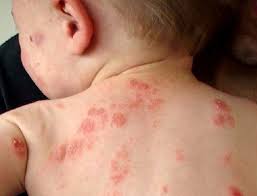
Allergic reactions to nutrient occur in approximately 5-ten% of children nether the age of 5 years. Allergic reactions to food are an immune-mediated response and ordinarily happen quite soon after ingestion of a food, resulting in hives, swelling, breathing difficulty, vomiting, or the child becomes floppy. If an allergic reaction occurs you should seek medical attending immediately. Allergic reactions near often occur to nuts, egg, milk, soy, wheat, fish and seafood, only a child can be allergic to other foods. Food intolerance is a non-immune-mediated response to foods and are more common in children and adults. Nutrient intolerance is normally a delayed reaction and common intolerances are lactose and fructose, resulting in intestinal pain, diarrhoea and unsettled behaviour.
Introducing allergens into a babies diet can be a business organization for some parents, especially if they accept a kid with allergy already or have nutrient allergy themselves. ASCIA recommends that even those at risk have introductions of nutrient allergens from around 6 months, and preferably have allergens introduced into the diet by 12 months of age. The bulk of children will non react to food allergens, however at that place are some children who may already accept a food allergy or have severe eczema and in these cases you should check with your GP or specialist. If your child needs to exclude foods from their nutrition due to food allergy, information technology is very important that you lot meet a Dietitian to ensure they are getting all the nutrients they demand for growth and evolution.
Innovate one new food every two days if you are concerned as this volition help you recognise if an allergic reaction has occurred. Once a food is introduced into your child's diet, then keep giving your child the food regularly to maintain tolerance to the food. If you are worried that your child may have an adverse reaction then it is a expert idea to introduce the food in the morn and have another adult in the house while you introduce the food. If you lot live far away from medical centre, then you may want to introduce the food near your GP or closest hospital.
Introducing nuts
Nuts are a great poly peptide source and full of swell calories and fatty for growing babies. Nuts can exist introduced from half dozen months and to help reduce allergy hazard they should be introduced by 12 months of age. Whole nuts should not offered until a child is five years erstwhile due to choking risk, so beginning with shine peanut/almond/cashew butters or nut flours, such as almond meal. When you lot first offer nut butters you tin give a small amount on your finger and place nut butter on the within of their mouth, so repeat this 20mins after. The following 24-hour interval offer a modest amount again and slowly increase amounts of nut butter or nut flours over a few days/weeks. For children with food allergy or for those with balmy eczema, then these guidelines are helpful for introducing peanut: https://world wide web.allergy.org.au/images/stories/pospapers/ASCIA_HP_guide_introduction_peanut_infants_2017.pdf. If your child has severe eczema and/or egg allergy information technology is important to consult with your specialist before introducing peanut.
Introducing egg
Egg is a great protein that most children honey. Eggs can be introduced from around 6 months, just non before 4 months. Eggs should exist introduced into your babies diet past 12 months of age to lower their adventure of egg allergy. It is a useful ingredient in baking and cooking. Egg should be well-cooked for the offset year of life. You can start with egg in baked foods, such equally muffins or pikelets. If these are tolerated so you can introduce scrambled and hard-boiled egg into the nutrition.
Introducing moo-cow'due south milk
In the first year of life breastmilk or baby formula should exist the main drink in the diet and these tin can as well be added into foods when starting on solids. Cow'due south milk tin can be introduced in broiled muffins or pikelets or as milk pulverisation contained in baby cereal. Yoghurt with probiotic cultures, such as acidophilus, tin exist introduced from around six months. Cow's milk can be added to cereals, puddings and into puree vegetables, merely should not be given as a main drink until afterward 12 months as information technology does not contain adequate nutrients for a baby.
Introducing soy
Soy is oft an ingredient in bread as soy flour and this can exist introduced from 6 months. Cooked soy milk tin can exist used in muffins or pikelets and and so used to mix cereal, puddings and in cooking if your family adopt soy milk. Soy sauce is quite high in salt and tin exist gradually introduced from around 12 months.
Introducing fish and shellfish
Fish is a fantastic protein and a groovy first food for babies. Fish tin be introduced from around half-dozen months. Offset with small amounts of white fish and then progress to fatty fish such as salmon and tuna as they get used to the flavour. Raw shellfish should non be given to babies and toddlers due to the risk of food-borne illness. Shellfish tin be introduced in the kickoff year of life if this is an important part of your families diet, only information technology will need to be given at an historic period-appropriate texture.
What equipment will you need?
You lot do non need to buy hundreds of pieces of equipment for feeding. If you are pureeing food you might want to invest in a hand mixer that you can then utilise for several years to make other foods, such equally soups, for the family unit. If you lot do non want to buy equipment, and then sieving food or mashing foods with a fork tin be just equally effective.
Your baby volition need a highchair or supportive chair to exist able to join you lot at the meal tabular array or wherever yous eat meals. A highchair should offer support so that your baby tin can sit down upright with their hips and knees at a 45-degree angle. Ideally, their anxiety should be on a footrest to assist them feel stable, but you tin make your own footrest with a stack of books or a box for their feet. A harness is useful to keep your baby from slipping and useful with toddlers to finish them from climbing out of their chair.
Bibs are useful for keeping your baby clean and I like bibs that also include sleeves, especially over the winter months when your babe might exist wearing long sleeve tops. Ones that are piece of cake to clean in-between uses tin can be helpful to reduce your laundry pile.
Initially, spoons should be silicone or plastic with a shallow depth to assist your baby take the nutrient off the spoon. Silicone or plastic spoons are gentler on your infant'southward gums than metal spoons. If your infant likes to feed themselves and then choose a silicone or plastic spoon with a wide handle to brand holding it easier.
Y'all can feed your babe direct from the highchair tray, from a normal basin or if they are placed at the table and feeding themselves you may want to choose a bowl with a suction pad to avoid your baby picking it up and throwing information technology on the floor. High direct sides on the bowl get in easier for your baby to scrape food onto a spoon independently.
Are extra supplements needed?
Vitamin D: The Ministry of Health in New Zealand recommends vitamin D supplementation for babies if they are at risk of deficiency, e.1000. they have darker skin, practice not go outdoors or alive in an expanse where there are less daylight hours. New Zealanders living in the lower south island may want to consider supplementation.
Iodine: If y'all are breastfeeding it is important that the mother continues on iodine supplements.
Folic Acrid: Mum's can restart folic acid supplementation if they wish to endeavour for another babe soon.
Probiotics: There is expert show that probiotics can help reduce diarrhoea in children and adults when they are taking antibiotics. At that place is some evidence that probiotics in the last trimester of pregnancy and the first year of life may help reduce eczema.
Summary
- Introduce solids from effectually 6 months but not before iv months
- Introduce allergen foods from 6 months, just not before four months. Make certain peanut and egg are introduced before 12 months
- If you are worried that your child is reacting to sure foods, see your GP, and/or a Paediatric Dietitian
- Take fun! Weaning on to solids should exist fun for both yous and your baby
- Take lots of photos of the mess!
Jennifer Douglas is a New Zealand Registered Dietitian specialising in children's nutrition, allergy and gut health. She runs clinics in Dunedin and sees individuals on skype. She besides runs workshops in Dunedin and virtually to parents groups around the land on babe feeding and family nutrition.
Extra reading from Jenny
How a Dietitian Can Help a Child with Food Allergy and Intolerance
Milk for the Allergy Baby
Some useful first recipes can be found at:
https://www.healthykids.org.nz/eat/articles/what-are-expert-first-foods-my-infant https://www.kidspot.com.au/kitchen/recipes/collection/baby-food-recipes
https://world wide web.kiwifamilies.co.nz/topic/babies/feeding-your-baby/infant-food-recipes/
http://conditions.wellness.qld.gov.au/HealthCondition/condition/8/78/414/introducing-solids-recipes-for-babies
For other information:
https://www.health.govt.nz/your-health/pregnancy-and-kids/commencement-yr/6-12-months/feeding-your-infant
https://world wide web.health.govt.nz/your-health/pregnancy-and-kids/under-fives/helpful-communication-years-1-v/feeding-your-child-i-year-and-over
https://www.wellness.govt.nz/your-health/pregnancy-and-kids/first-year/6-12-months/feeding-your-babe/babe-led-weaning
https://www.allergy.org.au/images/pcc/ASCIA_PCC_How_to_introduce_solid_foods_FAQ_2018.pdf
https://www.allergy.org.au/images/pcc/ASCIA_PCC_How_to_introduce_solid_foods_FINAL.pdf
https://world wide web.allergy.org.au/images/pcc/ASCIA_Guidelines_infant_feeding_and_allergy_prevention.pdf
Disclaimer: This blog is written past Jennifer Douglas who is a New Zealand Registered Dietitian. It is intended every bit a source of additional information only does non supercede that of your medical professional. If you have concerns near you or your child'southward health, then contact your wellness provider.
Source: https://www.jumpstartnutrition.co.nz/starting-your-baby-on-solids/
0 Response to "How to Feed the Baby Real Food on Live"
Post a Comment